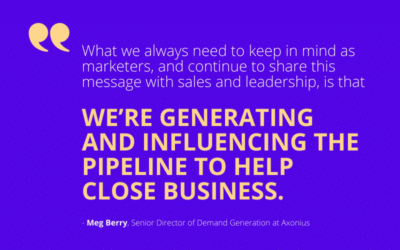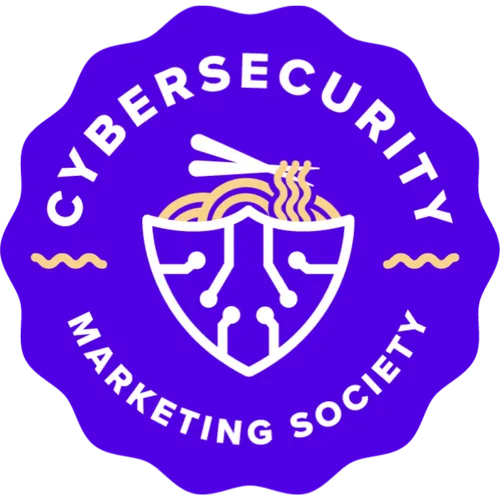Cybersecurity Demand Generation Red Flags: Seeing the Iceberg Before You Hit It


On September 21-September 24, the smartest minds in cybersecurity marketing came together for CyberMarketing Con 2020, run by the Cybersecurity Marketing Society. Panelists covered a wide span of categories, providing guidance for professionals looking to expand their business and improve their marketing skills.
In the session “Cybersecurity Demand Generation Red Flags: Seeing the Iceberg Before You Hit It,” Meg Berry, Senior Director of Demand Generation at Axonius, shared her tips on keeping an eye out for certain red flags in cybersecurity demand generation.
Although her recent experience is specific to cybersecurity marketing, these red flags apply to other industries as well. As she said, “It’s just as important to plan for the campaign as well as to plan for what can go wrong.” Baking potential roadblocks into your plan helps you prepare for chaos.

Virtual Everything
With COVID, large conferences and events are no longer tenable, especially for the foreseeable future. Earlier in the year, Berry and her team set the expectation for her company that no one would sign up for any in-person events through the rest of 2020, which not only protects the team but protects the company’s budget in case of a cancellation.
Now that there is “virtual everything,” Berry noted that there are several characteristics that marketers should pay attention to when agreeing to sign up for virtual conferences. With everything online, it is difficult to grab the attention of participants:
- Platform capability and limitations: It’s hard to stand out in a virtual event when every vendor has access to the same platform capabilities, creating similar booths. When researching the event, it is important to determine what the attendee experience will look like and what the platform can provide before signing up.
- Timing expectations: Many organizers may believe that vendors need less time to prepare for a virtual event because they don’t need all the physical assets. Marketers should understand the timing expectations for every deliverable involved, from contract to fulfillment, to ensure everything is on track.
- Giving yourself the best chance to stand out: There are not a ton of ways to stand out virtually. Grab any opportunity to differentiate yourself and attract attention.
- Zoom fatigue and virtual burnout: Be cautious of the time commitment you ask from participants. In virtual Zoom meetings, engagement is usually lower. This engagement should inform follow-up strategy.
1:1 Meeting Events
Virtual 1:1 meeting events are not what they seem. Berry discussed certain aspects to keep an eye out on when researching them:
- Is it too good to be true? These events promise a lot, but in the end, it is unlikely the promises will materialize. Look out for the event theme and who is attending. Many C-level executives don’t have to pay to attend, so they may not feel any obligation to show up to certain sessions.
- Varying opinions of the sales team: The sales team needs to be fully on board with the event so you can prove its value. In Berry’s experience, the sales team at earlier stage companies are more interested in these 1:1 events because of the opportunity to get directly in front of the target buyer, perfect the sales pitch, and spark interest in new technology. The sales team at a more established company may be less interested because of the time commitment, and they rather focus on their inbound process. She said, “If the sales team isn’t excited about these events, they don’t return the investment that you need to prove the event is a success.”
- High price tag: These events are extremely expensive, so there needs to be solid buy in from the sales team with a solid plan to prove ROI. Often, there may be no-shows, which leaves the sales team unprepared if they talk to a prospect they didn’t research. It is essential for marketers to share success metrics with the event vendor to outline exactly what you expect to be delivered.
Quantity vs. Quality
Often, marketers indulge in unrealistic goal setting that comes from the desire to please the sales team. But marketers help drive the pipeline. Berry said, “What we always need to keep in mind as marketers, and continue to share this message with sales and leadership, is that we’re generating and influencing the pipeline to help close business. That is the ultimate goal and will always be the ultimate goal.”
If prospects aren’t of quality, the work is not worthwhile. As a marketer, you need to set expectations with the sales team on quality over quantity. Red flags indicating quantity over quality include trading booth scans at events, database entries, and list purchases.
Stupid Prizes
Berry learned from her own personal experience to never give away stupid prizes, such as a car. No one wants one, no one can accept them, and no one really cares. Ultimately, the person you don’t want to win, such as a person not interested in your company or technology, will win the big prize. Make sure your prizes are meaningful. Often, there is more engagement when the prize includes a charitable component.

Thinking Your Job Is Done
“We are marketers, and our job is never done.” Berry discusses how the marketing funnel is actually more of a marketing circle, consisting of capturing, qualifying, nurturing, and transferring customers.
As Berry said, “Nurturing and marketing doesn’t end once they become a customer. I’d argue it becomes more important once they become a customer. You did something right to bring them on, and you don’t want to neglect them at one point because they are ultimately going to become your biggest selling point moving forward if they have a seamless experience”
Being Truthful With Your Deadline
As a bonus, Berry added that being truthful with your deadlines is a red flag. If a vendor doesn’t deliver on a true deadline, trouble will ensue. Marketers need to develop an internal deadline for employees at their own companies and also an external deadline, and both dates need to incorporate buffer time. This way, you are prepared if something goes awry.
There is no perfect way to approach demand generation, but there are definitely key events that may lead to problems. If you’re interested in learning more about what to watch out for in cybersecurity demand generation, visit https://cybermarketingcon2020.heysummit.com/ to watch the full panel session.

.png)
.png)
.png)